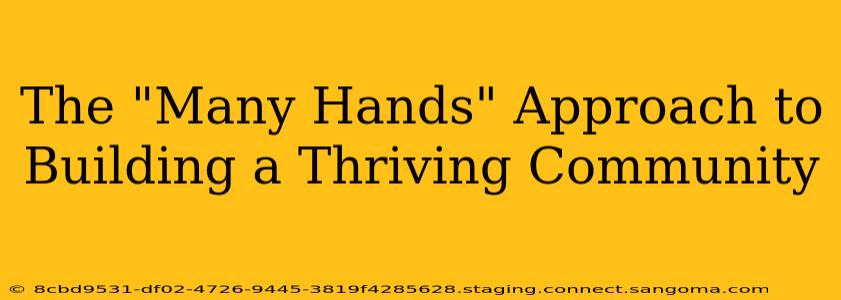Building a thriving community isn't a solo act; it's a symphony of collaboration and shared effort. The "many hands" approach emphasizes the power of collective contribution, recognizing that a strong community is built not just by a few dedicated individuals, but by the active participation of many. This article explores the strategies and principles behind this collaborative approach, revealing how fostering a sense of ownership and shared responsibility can lead to a vibrant and sustainable community.
What is the "Many Hands" Approach?
The "many hands" approach, at its core, is about distributed leadership and collective action. Instead of relying on a single leader or a small group to drive all initiatives, this approach encourages every member to contribute their unique skills and talents. It leverages the collective intelligence and diverse perspectives within the community to achieve shared goals. This isn't about assigning tasks; it's about creating an environment where individuals feel empowered to take initiative and contribute meaningfully.
How Does the "Many Hands" Approach Work in Practice?
The success of a "many hands" approach hinges on several key elements:
1. Fostering a Culture of Participation:
This involves creating a welcoming and inclusive environment where everyone feels valued and heard. Open communication channels, regular community gatherings (online or offline), and opportunities for feedback are crucial. Clear guidelines and expectations, communicated transparently, help members understand their roles and how they can contribute effectively.
2. Identifying and Leveraging Individual Strengths:
Recognizing and utilizing the diverse skills and talents within the community is vital. This might involve creating opportunities for members to share their expertise through workshops, mentorship programs, or simply by encouraging them to take the lead on projects that align with their interests.
3. Decentralizing Decision-Making:
While centralized leadership might be necessary for certain aspects, the "many hands" approach strives for a more democratic decision-making process. This could involve utilizing voting systems, collaborative platforms, or establishing committees to ensure diverse perspectives are considered.
4. Celebrating Contributions and Recognizing Achievements:
Publicly acknowledging and celebrating the contributions of individuals and groups significantly boosts morale and encourages further participation. This could involve shout-outs in newsletters, social media recognition, or even small awards and tokens of appreciation.
What are the Benefits of a "Many Hands" Approach?
The advantages of adopting a "many hands" approach to community building are numerous:
- Increased Ownership and Engagement: Members feel a greater sense of responsibility and ownership when they are actively involved in shaping their community.
- Greater Resilience: A community built on diverse contributions is more resilient to challenges and changes.
- Enhanced Creativity and Innovation: The collective intelligence of many minds leads to more creative and innovative solutions.
- Stronger Social Bonds: Collaboration fosters stronger relationships and a greater sense of belonging among community members.
- Improved Sustainability: A community that relies on the active participation of many is more likely to be sustainable in the long term.
How Can I Implement the "Many Hands" Approach in My Community?
Implementing a "many hands" approach requires a deliberate and proactive effort:
- Start small: Begin by identifying a few key areas where community participation can be easily integrated.
- Encourage experimentation: Don't be afraid to try different approaches and learn from your experiences.
- Embrace feedback: Regularly solicit feedback from members to identify areas for improvement.
- Celebrate success: Acknowledge and celebrate milestones achieved through collective effort.
What if Some Members Aren't Contributing?
It's important to acknowledge that not all members will be equally active. The goal is not to force participation, but to create an environment where individuals feel welcomed and encouraged to contribute at their own pace and capacity. Open communication and a supportive community atmosphere can often address any reluctance to participate.
By embracing the "many hands" approach, communities can harness the power of collective effort to create vibrant, resilient, and sustainable environments where everyone feels valued and empowered to contribute to their shared future. It's a journey of collaboration, learning, and shared success.

